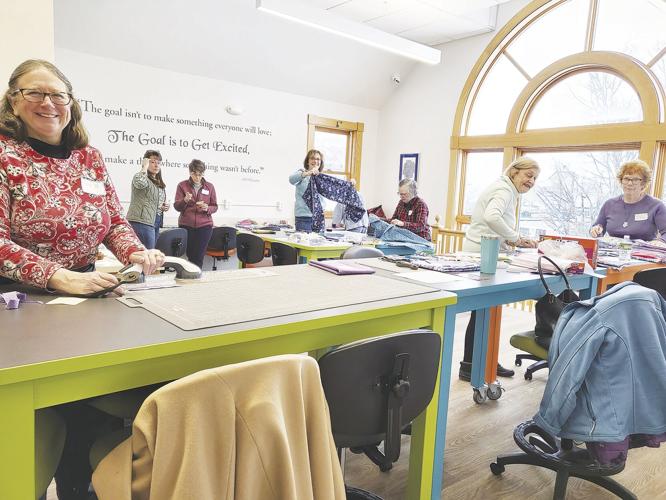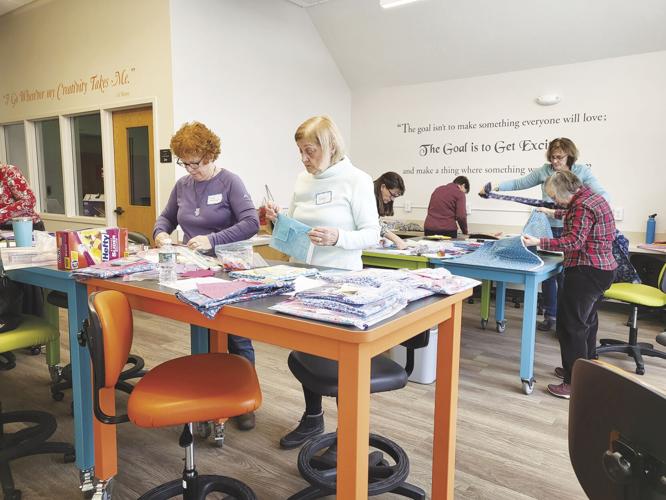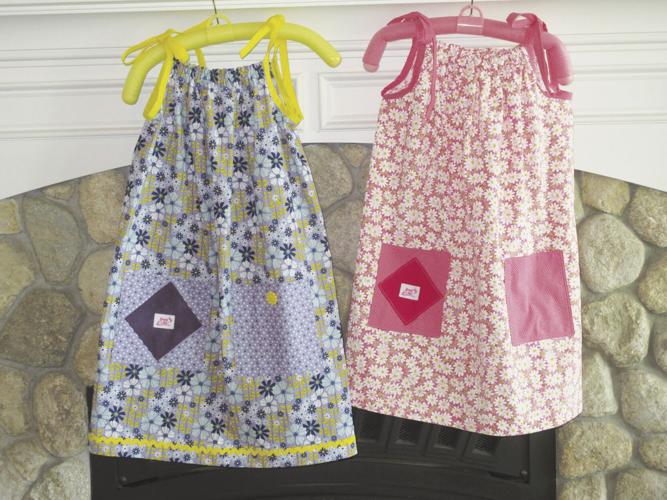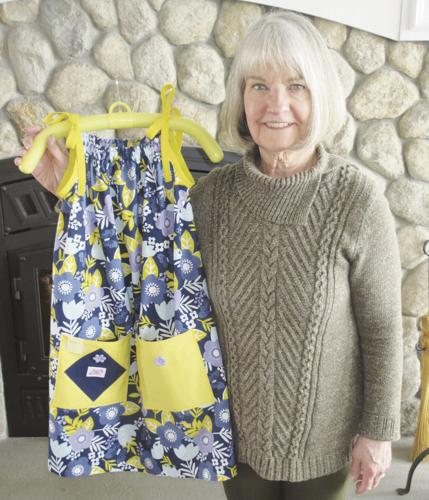MEREDITH — Every girl deserves at least one dress, says the front page of the Dress a Girl Around the World flyer. It is a sentiment shared by Connie Dehnel of Meredith and the women who have joined her to sew dresses for girls around the world.
Dehnel grew up in New Jersey and at one time took a course at the Fashion Institute of Technology in New York City. While there, she learned to sew.
The road to volunteering for Dress a Girl Around the World came about when Dehnel’s husband, a member of the Meredith Rotary, was on a Zoom call with other Rotarians. “There was a Rotarian from Vermont on the call, and she mentioned she was involved in Dress a Girl. My husband thought it might be something I would be interested in, since I love to sew,” Dehnel remembers.
In March of 2021, Dehnel and two local women, all skilled seamstresses, began to sew simple little sundresses for Dress a Girl Around the World. Dehnel now makes over 100 dresses a year, while other local woman sew as much as their schedules allow. The entire Dress A Girl organization makes over 3 million dresses a year, which are sent around the world and given to girls in impoverished areas.
Some of the girls have never owned a dress before, and many are at risk of being trafficked. The gift of a simple sundress gives them dignity and joy and shows their communities someone loved them enough to make a dress just for them.
Dress a Girl Around the World was started by Rachel Cinader. According to information at angelsofmercyny.org, “Dress a Girl Around the World was established in 2009 after founding member Rachel Eggum Cindar returned from Uganda, where she was part of an empowerment project for ladies called Smile Africa. Sewing with African ladies pushed her to start a new initiative, and now Dress a Girl Around The World has gained much public support.”
Currently, there are groups of women worldwide, from the United States, Canada, Australia, European countries, Costa Rica, Uganda, and many other places. Some women sew alone in their homes, while others join to sew in groups. No matter the location, the goal is to make simple sundresses for girls the world over.
Making and gifting dresses for girls might seem a frivolous thing in countries where wars rage and poverty is the norm. Those are also places where sex trafficking is frequent. However, when a sex trafficker sees a girl wearing a dress, they also see a Dress a Girl label on an outside pocket. The label is sewn to each dress in a very visible place (a pocket), and if the potential abductor sees that label, they know the girl is well taken care of and not living in poverty with no one to watch out for her. Abducting a cared-for child could be too much of a risk for a trafficker; thus they leave the child untouched and move on.
“We make dresses from sizes 3 to 10, and they are donated to 90 countries, including the United States,” Dehnel explains. The dresses are simple, but some specifications must be followed when making a garment. “We cannot use fabric with sequins or see-through material,” says Dehnel. She adds that part of the fun of making a sundress is choosing the fabric. “Little girls like bright-colored fabrics, animals and flowers. We choose the fabrics and make each dress using a simple sundress pattern.”
The pockets on the dresses are essential because they will bear the Dress a Girl label. The corners of the dresses are reinforced, and double stitching is used to ensure the dresses will last.
If someone wants to volunteer for Dress a Girl but is not skilled at sewing, there are other ways to help. Donors can purchase fabric (one yard or more), or if they have a stash of a yard or more of material or know someone who does, they can donate it to Dress a Girl. “You can also donate 0.5- and/or 0.75-inch non-roll elastic or extra-wide double fold bias tape in any color. Another much-needed item to purchase and donate is one or two gallon Ziploc bags for dress kits. We also need volunteers who can wash and iron fabric before we use it,” Dehnel adds. Volunteers can join others at a kit-making workshop to assemble items into Ziplock bags or donate funds.
Once completed, the dresses are sent to a chapter in Vermont then distributed worldwide.
Each finished dress is packed into a shoebox with underwear and a small toy, creating a practical yet precious gift for a girl. In many cases, this will be the first dress a girl has ever had, making the clothing, accessories and toy quite special. The girls may not know it when they wear the dress, but it is also saving them from a potential life of misery and possible death had they been trafficked.
Dehnel sews many dresses yearly and spreads the word about how people can help Dress a Girl. She speaks at local clubs and helps organize the finished dresses before they are taken to Vermont. Once in Vermont, the dresses are inspected, and an EMT group does any necessary mending to make sure all dresses are in top-notch shape. “EMT stands for Emergency Mending Team,” adds Dehnel.
Sewing dresses is time consuming and spreading the word about Dress a Girl also takes up much of Dehnel’s time, but it is well worth it. “These dresses help protect children. The organization continues to grow, and I plan to keep making dresses for girls worldwide.”
For information on Dress a Girl Around the World or to volunteer to sew or donate fabric or other items, email Dehnel at gcdehnel@verizon.net, call 603-677-7910 or visit dressagirlaroundtheworld.com.





















(0) comments
Welcome to the discussion.
Log In
Keep it Clean. Please avoid obscene, vulgar, lewd, racist or sexually-oriented language.
PLEASE TURN OFF YOUR CAPS LOCK.
Don't Threaten. Threats of harming another person will not be tolerated.
Be Truthful. Don't knowingly lie about anyone or anything.
Be Nice. No racism, sexism or any sort of -ism that is degrading to another person.
Be Proactive. Use the 'Report' link on each comment to let us know of abusive posts.
Share with Us. We'd love to hear eyewitness accounts, the history behind an article.